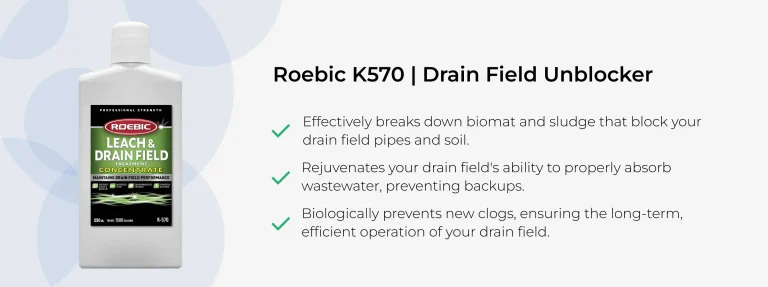Home » Knowledge base » Drain Field Unblocker
Drain Field Unblocker
A septic tank connected to a drain field is an ideal solution when no centralized sewage system is available. It’s also an environmentally sustainable choice, as it purifies wastewater and returns it safely to nature.
Blockages in Your Drain Field
This is an excellent system for situations without access to a sewer network. However, it’s also a system that is highly sensitive to issues like blockages. To better understand how these clogs occur, let’s first look at how the system works:
- Wastewater inflow: Household wastewater (from toilets, showers, kitchen, etc.) flows into the septic tank.
- Separation in the septic tank: Heavier solids settle at the bottom (sludge), while fats and lighter materials float to the top (scum). The middle layer contains relatively clear water.
- Primary treatment: Bacteria inside the tank partially break down organic matter.
- Discharge to the drain field: The partially treated water exits the tank and is distributed via perforated pipes into the drain field.
- Infiltration and natural filtration: The water slowly seeps into the surrounding soil, where it is further cleaned by soil particles and microorganisms.
- Return to groundwater: The treated water eventually reaches the groundwater without harming the environment.
Blockages typically occur in the final phase, where the filtered wastewater re-enters the soil. This happens through perforated pipes—tiny holes that can easily clog over time, leading to serious drainage issues.
What Causes Clogged Drain Field Pipes?
- Sludge (Biofilm): This is the primary cause. Even after septic tank treatment, the effluent still contains dissolved organic matter, bacteria, and fine solids. When this effluent enters the drain field and contacts the soil, bacteria form a biological slime layer—known as a biomat or biofilm—on the inside of the pipes and surrounding soil. Over time, this biofilm thickens and drastically reduces permeability.
- Suspended Solids: Despite settling in the septic tank, fine, non-settleable particles (organic matter, fibers, sludge) can still enter the drain field. These materials may attach to the biofilm or settle in the pipe, restricting flow.
- Fats and Oils: While a grease trap captures much of the fat, small amounts can still enter the effluent. These fats can solidify in cooler drain field pipes, stick to pipe walls, and promote further biofilm growth. They may also clog the pores in the surrounding soil.
Our Advice: Unblock and Prevent Clogs in Your Drain Field with Roebic K570
To effectively resolve and prevent blocked pipes, we recommend using a product that contains aerobic bacteria. Our top choice is Roebic K570 Drain Field Unblocker. This product contains patented aerobic bacteria that actively and efficiently break down the organic waste responsible for clogs. Roebic K570 not only clears existing blockages in your drain field system—it can also be used preventively for long-term protection.


